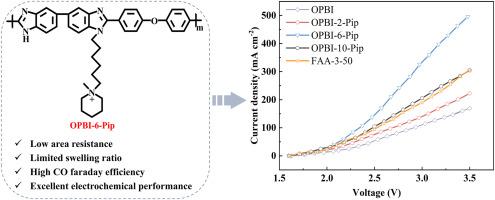Using “rigid - flexible” collaborative strategy to construct high performance alkyl - piperidinium grafted polybenzimidazole membranes for efficient CO2 reduction
IF 9
1区 工程技术
Q1 ENGINEERING, CHEMICAL
引用次数: 0
Abstract
Polybenzimidazole (PBI) membrane demonstrates considerable potential for application in electrochemical CO2 reduction (ECR), owing to its exceptional physicochemical properties. However, the PBI is limited by its intrinsic low ionic conductivity. Grafting is an effective method for enhancing microphase separation and ionic conductivity for PBI membrane. Here, a series of piperidinium-functional OPBI membranes (OPBI-n-Pip, n = 2, 6, 10) were designed and prepared using the “rigid-flexible” collaborative strategy. The backbone of OPBI-n-Pip polymer effectively suppress membrane swelling, while flexible piperidinium cations side chains offer dimensional stability and ionic conductivity. Furthermore, the ion transport and stability mechanism of OPBI-n-Pip membranes are revealed by molecular dynamics (MD) simulations and density functional theory (DFT) calculations. Notably, OPBI-6-Pip membrane exhibited best performance such as low area resistance (0.16 Ω cm2, at 20 °C), limited swelling ratio (25.0 %) and robust alkaline stability in 1 M KOH (91.6 % retention after 1440 h, at 30 °C). In ECR systems, the OPBI-6-Pip membrane demonstrated high CO faraday efficiency (FEco) of 93.6 % at 100 mA cm−2. This work provides good guidance for the practical implementation of PBI in electrochemical energy systems.

采用“刚性-柔性”协同策略构建高性能烷基-哌啶接枝聚苯并咪唑高效CO2还原膜
聚苯并咪唑(PBI)膜由于其特殊的物理化学性质,在电化学CO2还原(ECR)中具有相当大的应用潜力。然而,PBI由于其固有的低离子电导率而受到限制。接枝是提高PBI膜微相分离和离子电导率的有效方法。本研究采用“刚柔”协同策略,设计并制备了一系列具有哌啶功能的OPBI膜(OPBI-n- pip, n = 2,6,10)。OPBI-n-Pip聚合物的主链有效地抑制了膜的膨胀,而柔性的哌啶离子侧链则提供了尺寸稳定性和离子导电性。此外,通过分子动力学(MD)模拟和密度泛函理论(DFT)计算揭示了OPBI-n-Pip膜的离子传输和稳定性机制。值得注意的是,OPBI-6-Pip膜表现出最佳的性能,如低面积电阻(0.16 Ω cm2,在20°C),有限的溶胀率(25.0%)和在1 M KOH中的强碱性稳定性(1440 h后,在30°C下保留91.6%)。在ECR系统中,OPBI-6-Pip膜在100 mA cm−2下的CO法拉第效率(FEco)高达93.6%。该工作为PBI在电化学能源系统中的实际应用提供了良好的指导。
本文章由计算机程序翻译,如有差异,请以英文原文为准。
求助全文
约1分钟内获得全文
求助全文
来源期刊

Journal of Membrane Science
工程技术-高分子科学
CiteScore
17.10
自引率
17.90%
发文量
1031
审稿时长
2.5 months
期刊介绍:
The Journal of Membrane Science is a publication that focuses on membrane systems and is aimed at academic and industrial chemists, chemical engineers, materials scientists, and membranologists. It publishes original research and reviews on various aspects of membrane transport, membrane formation/structure, fouling, module/process design, and processes/applications. The journal primarily focuses on the structure, function, and performance of non-biological membranes but also includes papers that relate to biological membranes. The Journal of Membrane Science publishes Full Text Papers, State-of-the-Art Reviews, Letters to the Editor, and Perspectives.
 求助内容:
求助内容: 应助结果提醒方式:
应助结果提醒方式:


